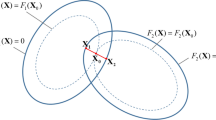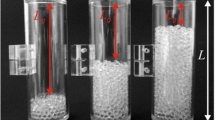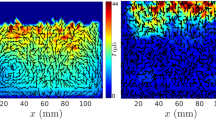Abstract
We study, via discrete element method simulations, the apparent mass (m, the ratio of a driving force to a resulting acceleration) and loss factor (\(\eta\), the ratio of dissipated to stored energy) of granular dampers attached to a vertically driven, single degree of freedom mechanical system. Granular dampers (or particle dampers) consist in receptacles that contain macroscopic particles which dissipate energy, when they are subjected to vibration, thanks to the inelastic collisions and friction between them. Although many studies focus on \(\eta\), less work has been devoted to m. The apparent mass of granular dampers is an important characteristic since the grains, which are free to move or collide inside their receptacle, act as a non-constant and time-dependent mass which alters the mass of the main vibrating system in a non-trivial way. In particular, it has been recently demonstrated (Masmoudi et al. in Granul Matter 18:71, 2016) that m non-linearly depends on the driving acceleration \(\varGamma\) according to a power law, \(m\propto \varGamma ^k\). Experiments using three-dimensional (3D) packings of particles suggest \(k=-2\). However, simulations with one-dimensional (1D) columns of particles on a vibrating plate and theoretical predictions based on the inelastic bouncing ball model (IBBM) suggest that \(k=-1\). These findings opened questions as to whether the apparent mass, which relies on how linear momentum is transferred from the damper to the primary system, depends on the dimensionality of the packing or on lateral interactions between walls and grains. Interestingly, \(\eta\) was shown to follow a universal curve, \(\eta \propto \varGamma ^{-1}\), whatever the dimensionality and the constraints in the motion of the grains. In this work, we consider granular dampers without a lid under different confinement conditions in the motion of the particles (1D, quasi-1D, quasi-2D and full 3D). We find that the mechanical response of the granular damper (m and \(\eta\)) is not sensitive to the lateral confinement or dimensionality. However, we have observed two distinct regimes, depending on whether the driving frequency is above or below the resonant frequency of the primary system. In the inertial regime, \(\eta\) decays according to the IBBM for all dimensions, \(\eta \propto \varGamma ^{-1}\), while m falls as \(\varGamma ^{-2}\) for all dimensions, in agreement with Masmoudi’s experiments. However, the power law for m is valid only for moderate acceleration, before becoming negative at high accelerations. In the quasi-static regime, both m and \(\eta\) display a complex behavior as functions of the excitation amplitude, but the mean trend is consistent with the IBBM predictions, i.e., \(m\propto \varGamma ^{-1}\) and \(\eta \propto \varGamma ^{-1}\).





Similar content being viewed by others
References
Panossian, H.V.: Structural damping enhancement via non-obstructive particle damping technique. J. Vib. Acoust. 114, 101–105 (1992). https://doi.org/10.1115/1.2930221
Simonian, S.S.: Particle beam damper. In: Proceedings of the SPIE Conference on Passive Damping, vol. 2445,pp. 149-160. Newport Beach, CA (1995)
Xu, Z., Wang, M.Y., Chenc, T.: Particle damper for vibration and noise reduction. J. Sound Vib. 270, 1033–1040 (2004). https://doi.org/10.1016/S0022-460X(03)00503-0
Marhadi, K.S., Kinra, V.K.: Particle impact damping: effect of mass ratio, material, and shape. J. Sound Vib. 283, 433–448 (2005). https://doi.org/10.1016/j.jsv.2004.04.013
Rongong, J., Tomlinson, G.: Amplitude dependent behaviour in the application of particle dampers to vibrating structures. In: 46th AIAA/ASME/ASCE/AHS/ASC Structures, Structural Dynamics and Materials Conference (2005). https://doi.org/10.2514/6.2005-2327
Lu, Z., Masri, S.F., Lu, X.: Origination, development and applications of particle damping technology. In: Particle Damping Technology Based Structural Control (2020). Springer Tracts in Civil Engineering. Springer, Singapore. https://doi.org/10.1007/978-981-15-3499-7_2
Jam, J.E., Fard, A.A.: Application of single unit impact dampers to reduce undesired vibration of the 3R robot arms. Int. J. Aerosp. Sci. 2(2), 49–54 (2013). https://doi.org/10.5923/j.aerospace.20130202.04
Duffy, K., Bagley, R., Mehmed, O.: On a self-tuning impact vibration damper for rotating turbomachinery. In: 36th AIAA/ASME/SAE/ASEE Joint Propulsion Conference and Exhibit. American Institute of Aeronautics and Astronautics (2000). https://doi.org/10.2514/6.2000-3100
Bannerman, M.N., Kollmer, J.E., Sack, A., Heckel, M., Mueller, P., Pöschel, T.: Movers and shakers: granular damping in microgravity. Phys. Rev. E 84, 011301 (2011). https://doi.org/10.1103/PhysRevE.84.011301
Sack, A., Heckel, M., Kollmer, J.E., Zimber, F., Pöschel, T.: Energy dissipation in driven granular matter in the absence of gravity. Phys. Rev. Lett. 111, 018001 (2013). https://doi.org/10.1103/PhysRevLett.111.018001
Menéndez, T.H., Sack, A., Pöschel, T.: Granular Leidenfrost effect in microgravity. Granul. Matter 22, 1–7 (2020). https://doi.org/10.1007/s10035-020-01040-y
Rivas, N., Luding, S., Thornton, A.R.: Low-frequency oscillations in narrow vibrated granular systems. New J. Phys. 15, (2013). https://doi.org/10.1088/1367-2630/15/11/113043
Rivas, N., Thornton, A.R., Luding, S., van der Meer, D.: From the granular Leidenfrost state to buoyancy-driven convection. Phys. Rev. E 91, (2015). https://doi.org/10.1103/PhysRevE.91.042202
Yang, M.Y.: Development of master design curves for particle impact dampers, Ph.D. Thesis, The Pennsylvania State University (2003)
Sánchez, M., Pugnaloni, L.A.: Effective mass overshoot in single degree of freedom mechanical systems with a particle damper. J. Sound Vib. 330, 5812–5819 (2011). https://doi.org/10.1016/j.jsv.2011.07.016
Masmoudi, M., Job, S., Abbes, M.S., Tawfiq, I., Haddar, M.: Experimental and numerical investigations of dissipation mechanisms in particle dampers. Granul. Matter 18, 71 (2016). https://doi.org/10.1007/s10035-016-0667-4
Araki, Y., Yokomichi, I., Inoue, J.: Impact dampers with granular materials: 2nd report, both sides impact in a vertical oscillating system. Bull. Jpn. Soc. Mech. Eng. 28(241), 1466–1472 (1985)
Mehta, A., Luck, J.M.: Novel temporal behavior of a nonlinear dynamical system: the completely inelastic bouncing ball. Phys. Rev. Lett. 65(4), 393 (1990)
Pastor, J.M., Maza, D., Zuriguel, I., Garcimartín, A., Boudet, J.-F.: Time resolved particle dynamics in granular convection. Phys. D 232(2), 128–135 (2007)
Sack, A., Heckel, M., Kollmer, J.E., Pöschel, T.: Probing the validity of an effective-one-particle description of granular dampers in microgravity. Granul. Matter 17, 73–82 (2015)
Sánchez, M., Carlevaro, C.M., Pugnaloni, L.A.: Effect of particle shape and fragmentation on the response of particle dampers. J. Vib. Control 20, 1846–1854 (2014). https://doi.org/10.1177/1077546313480544
Windows-Yule, C.R.K., Blackmore, D.L., Rosato, A.D.: Energy decay in a tapped granular column: can a one-dimensional toy model provide insight into fully three-dimensional systems? Phys. Rev. E 96, 042902 (2017). https://doi.org/10.1103/physreve.96.042902
Mao, K., Wang, M.Y., Xu, Z., Chend, T.: DEM simulation of particle damping. Powder Technol. 142(2–3), 154–165 (2004). https://doi.org/10.1016/j.powtec2004.04.031
Saeki, M.: Impact damping with granular materials in a horizontally vibration system. J. Sound Vib. 251(1), 153–161 (2002). https://doi.org/10.1006/jsvi.2001.3985
Bai, X.M., Keer, L.M., Wang, Q.J., Snurr, R.Q.: Investigation of particle damping mechanism via particle dynamics simulations. Granul. Matter 11, 417–429 (2009). https://doi.org/10.1007/s10035-009-0150-6
Fang, X., Tang, J.: Granular damping in forced vibration: qualitative and quantitative analyses. J. Vib. Acoust. 128, 489–500 (2006). https://doi.org/10.1115/1.2203339
Sánchez, M., Rosenthal, G., Pugnaloni, L.A.: Universal response of optimal granular damping devices. J. Sound Vib. 331, 4389–4394 (2012). https://doi.org/10.1016/j.jsv.2012.05.001
Cundall, P.A., Strack, O.D.L.: A discrete numerical model for granular assemblies. Geotechnique 29, 47–65 (1979)
Pöschel, T., Schwager, T.: Computational granular dynamics: models and algorithms. Springer, Berlin, Heidelberg (2005)
Schäfer, J., Dippel, S., Wolf, D.E.: Force schemes in simulations of granular materials. Journal de Physique I(6), 5–20 (1996)
Kruggel-Emden, E., Simsek, S., Rickelt, S.W., Scherer, V.: Review and extension of normal force models for the discrete element method. Powder Technol. 171, 157–173 (2007). https://doi.org/10.1016/j.powtec.2006.10.004
Kruggel-Emden, H., Wirtz, S., Scherer, V.: A study on tangential force laws applicable to the discrete element method (DEM) for materials with viscoelastic or plastic behavior. Chem. Eng. Sci. 63, 1523–1541 (2008). https://doi.org/10.1016/j.ces.2007.11.025
Allen, M.P., Tildesley, D.J.: Computer simulation of liquids. Oxford Science Publications, Oxford (1989)
Goldstein, H.: Classical Mechanics, 3rd edn. Addison Wesley, Boston (2002)
Kadanoff, L.P.: Built upon sand: theoretical ideas inspired by granular flows. Rev. Mod. Phys. 71, 435 (1999)
McNamara, S., Young, W.R.: Inelastic collapse and clumping in a one-dimensional granular medium. Phys. Fluids 4, 496 (1992)
Windows-Yule, C.R.K., Rosato, A.D., Thornton, A.R., Parker, D.J.: Resonance effects on the dynamics of dense granular beds: achieving optimal energy transfer in vibrated granular systems. New J. Phys. 17, 023015 (2015). https://doi.org/10.1088/1367-2630/17/2/023015
Salueña, C., Pöschel, T., Esipov, S.E.: Dissipative properties of vibrated granular materials. Phys. Rev. E 59, 4422 (1999). https://doi.org/10.1103/PhysRevE.59.4422
Windows-Yule, C.R.K., Rosato, A.D., Parker, D.J., Thornton, A.R.: Maximizing energy transfer in vibrofluidized granular systems. Phys. Rev. E 91, 052203 (2015). https://doi.org/10.1103/PhysRevE.91.052203
Job, S., Melo, F., Sokolow, A., Sen, S.: Solitary wave trains in granular chains: experiments, theory and simulations. Granul. Matter 10, 13–20 (2007). https://doi.org/10.1007/s10035-007-0054-2
Acknowledgements
We are grateful to Martín Sánchez for help with the simulations. This work was funded by ANPCyT (Argentina) through grant PICT-2016-2658. The first author (MVF) is grateful for the financial support of both Supméca and Campus France during her stay in France, at the laboratoire Quartz EA-7393.
Author information
Authors and Affiliations
Corresponding authors
Ethics declarations
Conflict of interest
The authors declare that they have no conflict of interest.
Additional information
Publisher's Note
Springer Nature remains neutral with regard to jurisdictional claims in published maps and institutional affiliations.
Rights and permissions
About this article
Cite this article
Ferreyra, M.V., Baldini, M., Pugnaloni, L.A. et al. Effect of lateral confinement on the apparent mass of granular dampers. Granular Matter 23, 45 (2021). https://doi.org/10.1007/s10035-021-01090-w
Received:
Accepted:
Published:
DOI: https://doi.org/10.1007/s10035-021-01090-w




